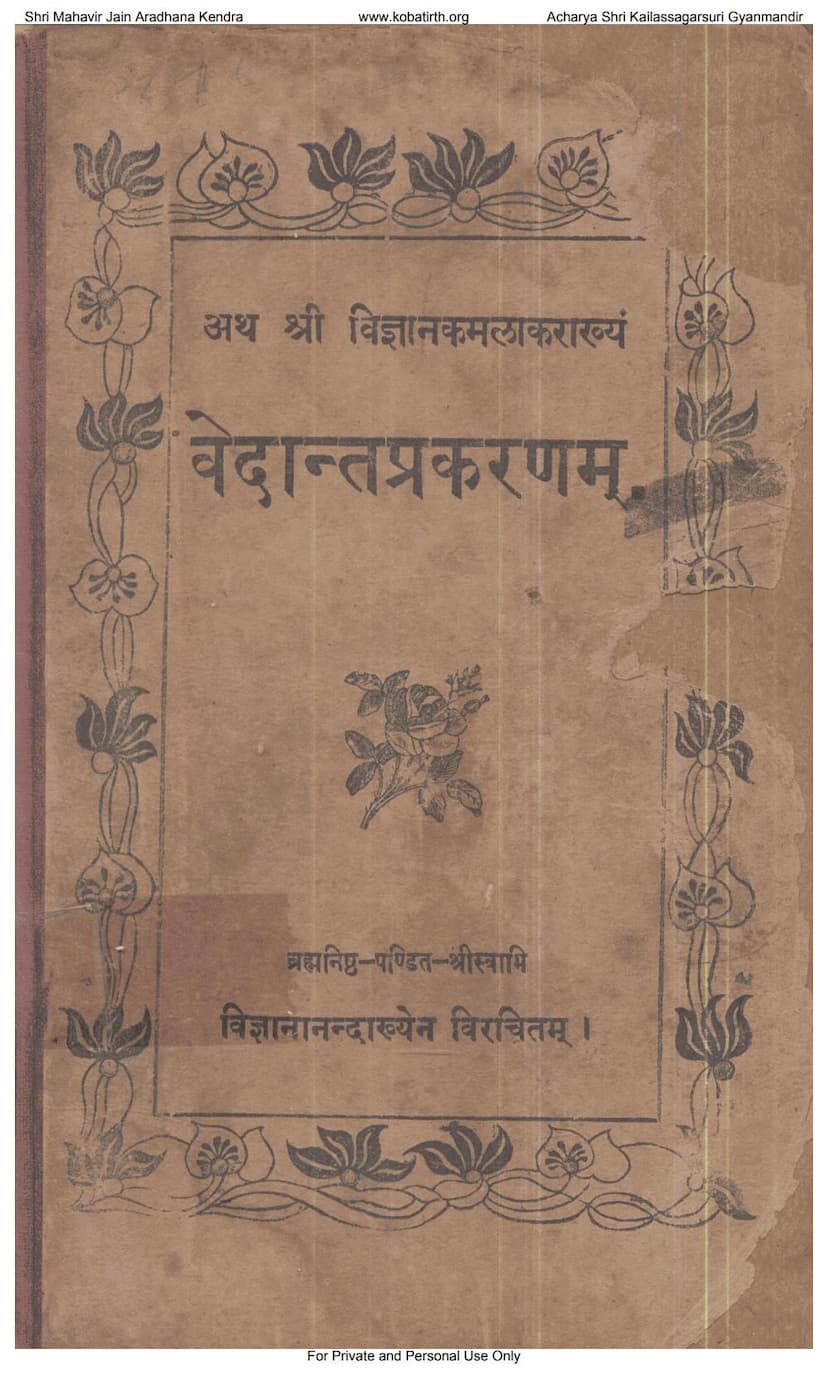Vedant Prakaranam
Added to library: September 2, 2025
Loading image...

Summary
This document is a summary of the Jain text "Vedant Prakaranam" authored by Vigyananand Pandit. The book, published by Sarasvati Chapkhanu, delves into Vedanta philosophy from a Jain perspective.
The summary covers the following key aspects:
- Title and Author: The book is titled "Vedant Prakaranam" (also referred to as "Shri Vigyanakamalakara"), authored by Brahmishtha Pandit Shri Swami Vigyanananda. It was published in Samvat 1972 (Shaka 1837) by Sarasvati Chapkhanu, Bhavnagar.
- Purpose and Content: The text aims to provide knowledge for the attainment of self-realization and to facilitate discussions on Vedanta within the framework of Jain philosophy. It summarizes the Six Systems of Indian Philosophy and includes a dialogue between Ashtavakra and a mendicant (Tapasi) regarding the nature of Brahman and the path to liberation.
- Structure: The book is divided into 26 "Kamals" (lotuses), each covering a specific philosophical topic.
- Key Philosophical Discussions: The summary details discussions on:
- Introduction (Page 4): Mentions the purpose of the book and lists the patrons who supported its publication.
- Sankhya Philosophy (Pages 9-12): Critiques the Sankhya concept of 25 Tattvas and the denial of Ishvara, arguing against its Vedanta-contradictory principles.
- Nyaya Philosophy (Pages 13-20): Analyzes the Nyaya concept of Ishvara, soul, and the nature of bondage and liberation, refuting its doctrines as contrary to Vedanta.
- Mimamsa Philosophy (Pages 20-35): Examines the Mimamsa focus on karma (ritual actions) for liberation, contrasting it with the Vedanta emphasis on knowledge and refuting its efficacy for true liberation.
- Six Tattvas (Pages 35-41): Discusses the six eternal principles (Brahman, Jiva, Ishvara, their distinction, Maya, and their union) as understood in Vedanta.
- Ashtanga Yoga (Pages 41-55): Explains the eight limbs of Yoga (Yama, Niyama, Asana, Pranayama, Pratyahara, Dharana, Dhyana, Samadhi) and their role in achieving liberation, differentiating between Savikalpa and Nirvikalpa Samadhi.
- Raja Yoga (Pages 56-64): Presents the teachings of Adi Shankaracharya on Raja Yoga, emphasizing the stages of spiritual realization (Jnana Bhumikas) and the importance of discrimination and detachment.
- Dialogue between Suraghu and Parigha (Pages 64-73): Recounts a conversation between two kings on the nature of Samadhi, liberation, and the illusory nature of the world.
- Anubandha (Contractual Relationships) (Pages 74-85): Explains the four Anubandhas: Vishaya (subject matter - unity of Jiva and Brahman), Prayojana (purpose - liberation from suffering and attainment of bliss), Sambandha (relationship between the subject and the text), and Adhikari (qualified student).
- Nature of Maya and Illusion (Pages 85-135): Discusses the concept of Maya and illusion, analyzing different theories of misapprehension (Khyati Vada) such as Asatkhyati, Atmakhyati, Anyathakhyati, and Anirvachaniyakhyati, ultimately advocating for the latter as the most fitting explanation for the perceived world.
- Dream State (Pages 136-157): Explores the nature of dreams, their relation to the waking state, and their illusory character, emphasizing the importance of realizing the underlying reality.
- Vajrasuchi Upanishad (Pages 167-172): Interprets the Vajrasuchi Upanishad, which critiques caste distinctions based on birth and asserts that true Brahmanhood is attained through spiritual knowledge and realization, not lineage.
- Dialogue between Ashtavakra and Tapasi (Pages 174-183): Details a conversation where Ashtavakra, initially proud of his knowledge, is humbled by a Tapasi's profound questions about the nature of the unmanifested Brahman.
- Dialogue between Prince and Yaksha (Pages 184-205): Presents a dialogue where a prince answers a Yaksha's questions about Brahman, its omnipresence, the path to liberation, and the nature of spiritual disciplines.
- Jivanmukta and Videhamukta (Pages 206-223): Explains the state of a Jivanmukta (liberated while living) and Videhamukta (liberated after death), emphasizing the eradication of ego and desires.
- The Role of Karma in Vedanta (Pages 223-262): Critiques the notion that learned individuals (Vipaschit) are bound by their past actions or rituals, arguing that true knowledge transcends karma and that the concept of accumulated karma applies to the unenlightened.
- Madaalsa's Teachings and Gopi Gita (Pages 263-267): Includes the devotional songs of Queen Madaalsa to her son and the Gopi Gita, highlighting the importance of devotion and the ultimate unity with the Divine.
The document concludes with a table of contents listing the "Kamals" and their corresponding page numbers. The text emphasizes the Jain understanding of Vedanta, focusing on self-realization, detachment, and the pursuit of spiritual knowledge as the path to liberation.